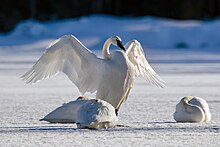| Trumpeter swan | |
|---|---|

| |
| Two trumpeter swans recorded at Rapids Lake Unit, Minnesota Valley NWR, Carver County, Minnesota | |
| Scientific classification | |
| Domain: | Eukaryota |
| Kingdom: | Animalia |
| Phylum: | Chordata |
| Class: | Aves |
| Order: | Anseriformes |
| Family: | Anatidae |
| Genus: | Cygnus |
| Species: | C. buccinator
|
| Binomial name | |
| Cygnus buccinator Richardson, 1831
| |

| |
| Range
Breeding Year-round Non-breeding
| |
The trumpeter swan (Cygnus buccinator) is a species of swan found in North America. The heaviest living bird native to North America, it is also the largest extant species of waterfowl, with a wingspan of 185 to 304.8 cm (6 ft 2 in to 10 ft 2 in).[3][4] It is the American counterpart and a close relative of the whooper swan (Cygnus cygnus) of Eurasia, and even has been considered the same species by some authorities.[5] By 1933, fewer than 70 wild trumpeters were known to exist, and extinction seemed imminent, until aerial surveys discovered a Pacific population of several thousand trumpeters around Alaska's Copper River.[6] Careful reintroductions by wildlife agencies and the Trumpeter Swan Society gradually restored the North American wild population to over 46,000 birds by 2010.[7]
- ^ BirdLife International (2021). "Cygnus buccinator". IUCN Red List of Threatened Species. 2021: e.T22679859A136992006. doi:10.2305/IUCN.UK.2021-3.RLTS.T22679859A136992006.en. Retrieved 19 November 2021.
- ^ "NatureServe Explorer 2.0". explorer.natureserve.org. Retrieved 10 November 2022.
- ^ Madge, Steve; Burn, Hilary (1988). Waterfowl: An Identification Guide to the Ducks, Geese, and Swans of the World. Boston: Houghton Mifflin. ISBN 978-0-395-46727-5.
- ^ "Trumpeter swan | Migratory, White, Waterfowl | Britannica".
- ^ Morony, John J.; Bock, Walter Joseph; Farrand, John (1975). Reference list of the birds of the world. New York: American Museum of Natural History. hdl:2246/6700. OCLC 483451163.
- ^ Nora Steiner Mealy (Spring 1988). "Heard Swans Reprise". California Wild. Retrieved 2015-07-04.
- ^ Cite error: The named reference
Groveswas invoked but never defined (see the help page).

